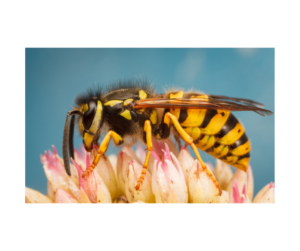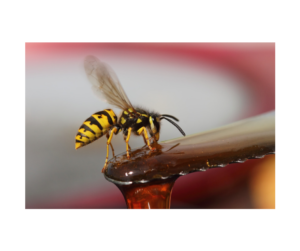 Yellow Jackets are a worldwide species identified by their typical yellow and black color pattern. They are extremely common in the United States, including Mechanicsville Virginia, especially in the summer and early fall. They are part of the Hymenoptera order and are social insects that live in nests and colonies. Their size ranges from 3/8 to 5/8 inches.
Yellow Jackets are a worldwide species identified by their typical yellow and black color pattern. They are extremely common in the United States, including Mechanicsville Virginia, especially in the summer and early fall. They are part of the Hymenoptera order and are social insects that live in nests and colonies. Their size ranges from 3/8 to 5/8 inches.
What should I know about Yellow Jackets?
The overwintering queen emerges in late spring and begins to develop her nest. She builds her nest from chewed-up cellulose material, which is used to start cells, and she then lays her eggs in each of those cells. It can take up to 30 days for the first few workers to emerge. Once they emerge, the nest begins to grow into a number of rounded paper combs attached to one below the other. The sizes of each nest can vary and contain up to thousands of workers.
What do Yellow Jackets eat?
 Yellow Jackets are very beneficial insects as they help control other insect populations. The adults feed off of nectar, mostly supplied to them by the larva in their nests. The Yellow Jacket adult collects food, such as other insects, and chews them up so their larva can consume them. In turn, the Larva secrete a sugary substance (nectar) for the adult workers to eat. This process is defined as Trophallaxis.
Yellow Jackets are very beneficial insects as they help control other insect populations. The adults feed off of nectar, mostly supplied to them by the larva in their nests. The Yellow Jacket adult collects food, such as other insects, and chews them up so their larva can consume them. In turn, the Larva secrete a sugary substance (nectar) for the adult workers to eat. This process is defined as Trophallaxis.
 A key point of understanding is in fall, the larva in a nest produces less nectar for adults, which results in workers foraging for sugary substance substitutes. Common areas are fruits and human trash can areas. This is why in the fall during sporting events these pests can be a real nuisance around park trash cans and common areas.
A key point of understanding is in fall, the larva in a nest produces less nectar for adults, which results in workers foraging for sugary substance substitutes. Common areas are fruits and human trash can areas. This is why in the fall during sporting events these pests can be a real nuisance around park trash cans and common areas.
What happens to them in the winter?
Towards the end of the season, new queens and males leave the nest/colony and begin to mate. Only the inseminated females hibernate, all other members die off, including the existing queen.
The overwintering inseminated queens look for shelter in wall voids, ground voids, and arial overwintering sites. Many times, they are found flying into homes seeking warmth during the winter months.
How do I treat for them?
 Nest sites are located in the ground, in hollow trees, or arial sites. The most common nest site for yellow jackets is a ground nest. Most nests have two access points; when threatened, yellow jackets become very aggressive and sting multiple times. Those of you who have been stung by them know how painful it is.
Nest sites are located in the ground, in hollow trees, or arial sites. The most common nest site for yellow jackets is a ground nest. Most nests have two access points; when threatened, yellow jackets become very aggressive and sting multiple times. Those of you who have been stung by them know how painful it is.
Control measures should be made at night when most of the workers are back in the nest/hive. If unable to treat at night, dust formulations are recommended as the returning members will transfer the product to the rest of the nest. Remove the nest, when possible, after treating it to void creating a dermestid beetle or other ectoparasites that develop from the dead larva, nest material, and cells left behind.
The application of liquid or aerosol products should only be used if you are treating the nest at night when most of the workers are there. After treatment, remove the nest to avoid future pest issues mentioned above.
Safety is the most crucial aspect when treating stinging insects and applying products. If possible, it is recommended to make applications using a bee pole or an extension-handle duster along with wearing a bee suit.
Yellow Jacket traps are effective in controlling the number of adults however they do nothing for eliminating the nest. The colony will continue to develop more workers than you can trap which is why you will notice a fluctuation in activity.
An All-Stars Pest Control professional is standing by and ready to answer any questions you may have when it comes to protecting your family, pets, and home.
